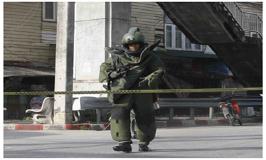The life-threatening danger of the third and fourth bombs
 Islamic extremists have become more innovative in the making and using of improvised explosive devices (IEDs) with the increasing use of a third or a fourth bomb at a single site of bombing attack with an apparent intention to kill or maim members of the bomb demolition squads.
Islamic extremists have become more innovative in the making and using of improvised explosive devices (IEDs) with the increasing use of a third or a fourth bomb at a single site of bombing attack with an apparent intention to kill or maim members of the bomb demolition squads.
Speaking on the condition of anonymity, a former senior police officer in charge of bomb demolition operations in the three violence-prone southernmost provinces recently told Isra news agency that the employment of a third bomb or more bombs at one single location of bombing attack has, lately, caused high casualties among civilians and members of the security forces, including bomb demolition squads.
“The extremists’ plot is to plant three or more bombs at a scene with the first bomb targeting innocent civilians such as rubber tappers. The first explosion was intended to lure officials to the spot of the blast. When the bomb demolition squad arrived to scour the explosion scene, they found the second bomb and thought the scene was safe and they became less careful. It was this time that the extremists who were observing the activities somewhere not too far away detonated the third or fourth bombs,” said the officer.
He suspected that the bombers or their supporters had been observing the operations of the bomb demolition squads all along in order to try to find out a loophole in the security net so they could exploit it for their future bombing attacks. He attributed the increased casualties among members of the security forces lately to the use of multi-bomb attacks.
The officer warned that members of the bomb demolition squads should not try to defuse every bomb found because it might not worth the risk. For safety sake, he suggested the use of water cannon to destroy the bomb or the IED as the number one rule. And if it is necessary to defuse a bomb, the officers must protect themselves by wearing a bomb suit and make use of other life-saving tools such as a mechanical arm which extends as long as three metre and a bomb blanket which can protect oneself from bomb shrapnels.
However, he noted that on several occasions, bomb demolition members did not wear bomb suits and tried to defuse bombs with their bare hands.
As for the bombs or the IEDs, he said that the bomb makers had not made much advance in the technique of bomb-making although they had become more innovative. He pointed out that, lately, the bomb-makers had turned to making simple IEDs using gun power and PVC pipes which are not powerful but difficult to detect with the use of landmine detectors.
The only piece of metal in these simple IEDs is the nine-volt battery and the rest are plastic which can hardly be detected unless the officers are highly skilled, said the police officer.
He went on saying that the basic use of jammer to disrupt the radio frequency emitted from a remote control or a cellphone to detonate a bomb is effective only within 5-10 metre radius from where a bomb is located.
“Like an umbrella, you will not get wet under the umbrella,” he said, adding that the extremists had, on several occasions, switched to the old method of using a cable linking the bomb to the detonator in order to beat the jammer.
Last but not least, another advice to the bomb demolition squads from this senior police officer is that: do not rush to defuse a bomb when all the devices need to defuse a bomb are not yet ready; and do not take unnecessary risk.
The followings are some of the bombing incidents in which a third bomb or a fourth bomb was detonated:
On June 24, suspected extremists exploded three bombs at a construction site of an irrigation project in Tak Bai district of Narathiwat, killing two construction workers and wounding 11 people, including nine police bomb demolition members.
On July 4, three members of an army bomb demolition squad were injured by the third bomb in Rue So district of Narathiwat.
On July 11, a rubber tapper was injured when he stepped on a bomb planted in a rubber plantation in Raman district of Yala. A bomb demolition squad which was rushed to the scene found one unexploded bomb, but one of them stepped on the third bomb, triggering an explosion which wounded 10 officials, three of them seriously and had to be rushed to a hospital in Songkhla for emergency treatment. A fourth was later found near the scene.
-----------------------------------------------------------------------------------------------------------------
Caption : The bomb demolition squad with bomb suit
Photo by : Abdulah Wangnhi
